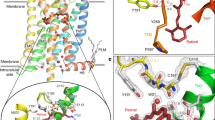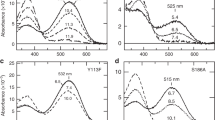Abstract
The early receptor potential produced by light absorbed by rhodopsin has two components. Of these R1, which develops most rapidly, is generated by chemical reactions involving prelumirhodopsin. R2, a later component, the waveform of which is calculated in the following article, is not directly generated by rhodopsin, and possibly develops in the surface membrane of the outer limb, as in invertebrates.
This is a preview of subscription content, access via your institution
Access options
Subscribe to this journal
Receive 51 print issues and online access
$199.00 per year
only $3.90 per issue
Buy this article
- Purchase on Springer Link
- Instant access to full article PDF
Prices may be subject to local taxes which are calculated during checkout
Similar content being viewed by others
References
Brown, K. T., and Murakami, M., Nature, 201, 624 (1964).
Cone, R. A., Nature, 204, 736 (1964).
Pak, W. L., and Cone, R. A., Nature, 204, 836 (1964).
Cone, R. A., Cold Spring Harbor Symp. Quant. Biol., 30, 483 (1965).
Cone, R. A., and Brown, P. K., Science, 156, 536 (1967).
Pak, W. L., Cold Spring Harbor Symp. Quant. Biol., 30, 493 (1965).
Brindley, G. S., and Gardner Medwin, A. R., J. Physiol., 182, 185 (1966).
Crawford, J. M., Gage, P. W., and Brown, K. T., Vision Res., 7, 539 (1967).
Abrahamson, E. W., and Ostroy, S. E., Biophysics and Mol. Biology, 17, 179 (1967).
Arden, G. B., and Ikeda, H., Nature, 208, 1100 (1965).
Cone, R. A., Science, 155, 1128 (1967).
Pak, W. L., and Boes, R. J., Science, 155, 1131 (1967).
Arden, G. B., Bridges, C. D. B., Ikeda, H., and Siegel, I. M., Vision Res., 8, 3 (1968).
Arden, G. B., Ikeda, H., and Siegel, I. M., Vision Res., 6, 357 (1966).
Hagins, W. A., and McCaughy, R. E., Science, 157, 813 (1967).
Dartnall, H. J. A., The Eye (edit. by Davson), 2 (Academic Press, 1962).
Porter, G., and Strauss, G., Proc. Roy. Soc., A., 295, 1 (1966).
Wulfe, V. W., Adams, R. G., Linschitz, H., and Abrahamson, E. W., Ann. NY Acad. Sci., 74, 281 (1958).
Arden, G. B., Bridges, C. D. B., Ikeda, H., and Siegel, I. M., Nature, 212, 1235 (1966).
Smith, T. G., and Brown, J. R., Nature, 212, 1217 (1966).
Hagins, W. A., and McGaughy, R. E., Science, 159, 213 (1968).
Author information
Authors and Affiliations
Rights and permissions
About this article
Cite this article
ARDEN, G., MILLER, G. Generation of the Vertebrate Early Receptor Potential and its Relation to Rhodopsin Chemistry. Nature 218, 646–649 (1968). https://doi.org/10.1038/218646a0
Received:
Issue Date:
DOI: https://doi.org/10.1038/218646a0
Comments
By submitting a comment you agree to abide by our Terms and Community Guidelines. If you find something abusive or that does not comply with our terms or guidelines please flag it as inappropriate.



